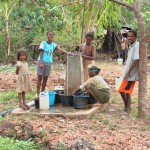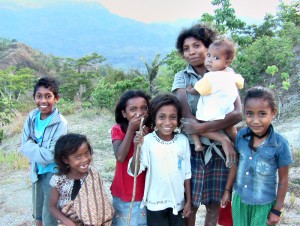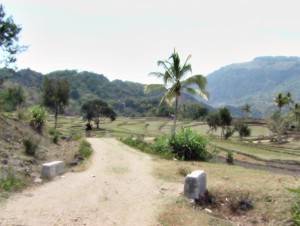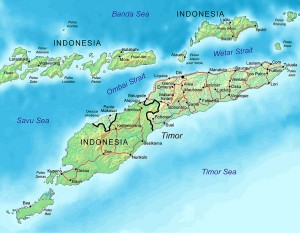Timor-Leste (East Timor) has emerged from foreign domination, war and bloody violence. It is a small country facing big challenges.
East Timor’s small size and geography have seen the country colonised by Portugal and then Indonesia.
Now an independent country, East Timor’s closest neighbours are Indonesia (who share an island with East Timor) and Australia.
Key dates in East Timor’s history
- 1515: Portuguese invade and establish colony.
- 1975: Portuguese depart; brief civil war; Indonesia invades.
- 1991: Dili massacre: Indonesian troops kill at least 250 in the Santa Cruz cemetery.
- 1999: Referendum votes for independence; Indonesia departs amid much destruction.
- 2002: Independence achieved.
- 2006–07: Riots, many killed and displaced; Ramos Horta becomes President.
- 2008: Failed coup attempt, Ramos Horta injured; UN troops enforce peace.
- 2010: Timor-Leste has a population of just under 1.2 million.
- 2012: Timor-Leste celebrates 10 years of independenec; Elections return Xanana Gusmão as prime minister and Taur Matan Ruak is elected president.
Some statistics
- More than 70 per cent of the population live in rural areas.
- More than half of rural households have chronic food shortages.
- About 40 per cent of the population have no access to clean water.
- The average birth rate is more than seven children for each woman.
- Six per cent of children die before they reach their fifth birthday.
- Almost half (46 per cent) of children are underweight for age.
- Life expectancy is 70.5 years for women, 65.5 years for men.
- Half the population lacks any formal education.
- About 40 per cent of the population live on less than 80 cents a day.
 Despite the poverty, there are signs of hope. In the decade since independence poverty rates have fallen by 20 per cent and Timor-Leste has risen 40 places in the United Nations human development index. Aid now accounts for less than 10 per cent of the economy. The democratic government is using substantial revenues from oil and gas to build schools and improve infrastructure. Timor-Leste spends more on education (16.8% of GDP) than any other country. Although the people have endured much, they are very positive about their future.
Despite the poverty, there are signs of hope. In the decade since independence poverty rates have fallen by 20 per cent and Timor-Leste has risen 40 places in the United Nations human development index. Aid now accounts for less than 10 per cent of the economy. The democratic government is using substantial revenues from oil and gas to build schools and improve infrastructure. Timor-Leste spends more on education (16.8% of GDP) than any other country. Although the people have endured much, they are very positive about their future.
- Primary school enrolment is 98 per cent.
- One-quarter of parliamentarians are women.
- One-third of the population is under the age of 15.
Culture and religion
 The people of East Timor are ethnically and culturally diverse, with influences from Portugal, Indonesia, Malaysia, China and Micronesia. Although illiteracy is high, there are rich oral traditions, and music and dance are an important part of life. Compared to Australia, the society is traditional, patriarchal and formal. Family ties are very strong, and networks and personal relationships among the small population are often more important than official channels. However, society is undergoing rapid change.
The people of East Timor are ethnically and culturally diverse, with influences from Portugal, Indonesia, Malaysia, China and Micronesia. Although illiteracy is high, there are rich oral traditions, and music and dance are an important part of life. Compared to Australia, the society is traditional, patriarchal and formal. Family ties are very strong, and networks and personal relationships among the small population are often more important than official channels. However, society is undergoing rapid change.
Most people speak one or more of the 38 indigenous languages. The official languages are Tetun and Portuguese, but in practice Tetun, Indonesian and English are most commonly used.
The population is overwhelmingly (98%) Catholic, though many people still follow animist traditions such as ancestor worship. The church and its personnel wield considerable power and influence.
Communications
 Throughout Timor-Leste the roads are extremely rugged and subject to flooding and landslips. Bus services between major centres are supplemented by mikrolets (minibuses), and a few individuals own motor scooters. Private cars are rare outside Dili and car hire is expensive.
Throughout Timor-Leste the roads are extremely rugged and subject to flooding and landslips. Bus services between major centres are supplemented by mikrolets (minibuses), and a few individuals own motor scooters. Private cars are rare outside Dili and car hire is expensive.
There is no postal service except to PO boxes in Dili. Text messages by mobile phone are the best method for quick communication; email generally gets through but is dependent on fluctuating electricity supplies.



Leave A Reply (No comments so far)
The comments are closed.
No comments yet